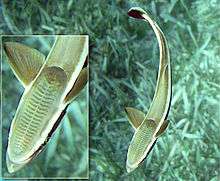Live sharksucker
The live sharksucker or slender sharksucker (Echeneis naucrates) is a species of marine fish in the family Echeneidae, the remoras.[2][3][4][5][6]
| Live sharksucker | |
|---|---|
 | |
| Scientific classification | |
| Kingdom: | Animalia |
| Phylum: | Chordata |
| Class: | Actinopterygii |
| Order: | Carangiformes |
| Family: | Echeneidae |
| Genus: | Echeneis |
| Species: | E. naucrates |
| Binomial name | |
| Echeneis naucrates Linnaeus, 1758 | |
| Synonyms[2] | |
| |
Distribution and habitat
The species is considered as circumtropical, as it occurs in all tropical and warm temperate waters around the world, except for the eastern Pacific.[1][2] The species can be found close to the coast, as well as offshore at a maximum depth of 50 m (160 ft).[7][8]
A live sharksucker is known to attach itself temporarily by its modified dorsal fin used as a sucking disc to various hosts, such as sharks, rays, large bony fishes, sea turtles, whales, dolphins, ships, and even sometimes scubadivers.[2] In Amami-Oshima, Japan, a population of non-attaching, resting upside-down on sandy floors exists and feeds on leftovers of foods for tunas in cages since around 2010, where individuals may attach to each other.[9]
Description

E. naucrates is a medium-sized fish which can grow up to 110 cm (43 in) length.[10] Its body is elongated and streamlined, and its lower jaw is clearly prognathic (it projects forward well beyond the upper jaw).[3] The jaws, vomer and tongue have villiform teeth.[3] The main distinctive feature to distinguish from other fishes is the oval-shaped sucking disc, which is a highly modified dorsal fin positioned from the top of the head to the anterior part of the body.[3]
The body background colouration is dark grey to dark brown, with a dark belly. A longitudinal stripe runs along the axis side of the body, it is always darker than its background colour with a whitish margin. The caudal fin is black with white corners.
Diet
According to its maturity or situation (with host or not) the remora's diet varies.
As a juvenile, it sometimes acts as a cleaner fish on reef station and its diet consists of small parasitic crustaceans living on the fishes' bodies, like copepods, isopods, and ostracods.[11]
With a host, the live sharksucker eats parasitic crustaceans from the latter, food scraps from the feeding activity of its host, or some small food caught by filtering the water through its villiform teeth while the navigating on its host.[12]
Without a host, the fish stays close to the shore and can aggregate with other individuals; its diet is then composed of free-living crustaceans, squid, and small fishes.[12]
References
- Collette, B.B.; Curtis, M.; Williams, J.T.; Smith-Vaniz, W.F. & Pina Amargos, F (2015). "Echeneis naucrates". IUCN Red List of Threatened Species. 2015: e.T190393A76649216. doi:10.2305/IUCN.UK.2015-4.RLTS.T190393A15603110.en.{{cite iucn}}: error: |doi= / |page= mismatch (help)
- Froese, Rainer and Pauly, Daniel, eds. (2019). "Echeneis naucrates" in FishBase. August 2019 version.
- "Slender Suckerfish, Echeneis naucrates (Linnaeus, 1758) - Australian Museum". australianmuseum.net.au.
- Slender Suckerfish, Echeneis naucrates (Linnaeus, 1758). australianmuseum.net.au
- Sharksucker. flmnh.ufl.edu
- "FLMNH Ichthyology Department: Sharksucker". ufl.edu. 2017-05-09.
- Cervigón, F., R. Cipriani, W. Fischer, L. Garibaldi, M. Hendrickx, A.J. Lemus, R. Márquez, J.M. Poutiers, G. Robaina and B. Rodriguez, 1992. Fichas FAO de identificación de especies para los fines de la pesca. Guía de campo de las especies comerciales marinas y de aquas salobres de la costa septentrional de Sur América. FAO, Rome..
- al Sakaff, H.; M. Esseen (1999). "Occurrence and distribution of fish species off Yemen (Gulf of Aden and Arabian Sea)" (PDF). Naga ICLARM Q. 22 (1): 43–47. Archived from the original (PDF) on 2015-11-29. Retrieved 2016-11-18.
- NHK, 2020, August 9, ダーウィンが来た! (Darwin ga Kita!)「ひっつかないコバンザメ!奄美の海で謎の大集結」
- Lieske, E. and R. Myers (1994). Collins Pocket Guide. Coral reef fishes. Indo-Pacific & Caribbean including the Red Sea. Harper Collins Publishers.
- Sazima, I.; R.L. Moura & M.C.M. Rodrigues (1999). "Juvenile sharksucker, Echeneis naucrates (Echeneidae), acting as a station-based cleaner fish". Cybium. 23 (4): 377–380.
- security. "DORIS - FFESSM - Biologie et plongée - Faune et flore sous-marines et dulcicoles". ffessm.fr.
External links
| Wikimedia Commons has media related to Echeneis naucrates. |
- Echeneis naucrates at Australian Museum.
- Echeneis naucrates at Encyclopedia of Life.
- Photos of Live sharksucker on Sealife Collection
